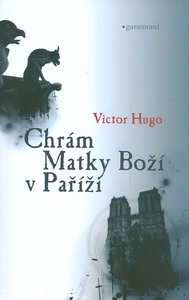Take a photo of a barcode or cover
O personagem principal, que mais destaque ganha, é, na verdade, a cidade de Paris. Vitor Hugo descreve e realiza um mapeamento impecável da mesma, com uma grande precisão em sua arquitetura, transformando o livro em, praticamente, um guia turístico da cidade. Ao destacar e elogiar tanto a Catedral, o parisiense tem o intuito valorizar sua estrutura medieval, que estava em um estado de péssima conservação por seus cidadãos. Desse modo, reforçando sua cultura e defendendo suas raízes históricas, Victor Hugo incentivou a restauração da Catedral, e Notre-Dame passou ser um dos grandes alvos de turistas do mundo todo.
Interagindo com Paris, temos os personagens secundários da trama: Quasímodo, de aparência mostrenga e com as pernas tortas com uma grande corcunda; Arquidiácono Frollo, que adota Quasímodo quando criança após este ser abandonando nos degraus da igreja; Esmeralda, a bela e encantadora cigana que dança nos degraus da Catedral; Gringoire, poeta e filósofo ex-aluno de Frollo; e Phoebus, o galanteador chefe da guarda local.
Apesar de muito diferentes, todos os homens da trama possuem um traço semelhante: são interessados em Esmeralda, e em cada personagem este interesse é demonstrado de maneira distinta.
Vitor Hugo utiliza de sua escrita para denunciar inúmeros preconceitos do século XIX, indo desde o racismo e perseguição dos estrangeiros (no caso de Esmeralda) e a segregação do deficiente dentro da sociedade (na situação de Quasímodo). Exemplo disso, é como o interesse do Arquidiácono se manifesta em Esmeralda: o homem nutre pela cigana, além do desejo sexual, um ódio descomunal por conta de suas origens e etnia, acusando-a até de bruxa, simplesmente por tê-lo feito se apaixonar.
Com um final triste, digno de uma boa escritura gótica, "O Corcunda de Notre-Dame" é uma leitura, apesar de maçante, essencial. Porém, é necessário ter em mente que a ideia do autor não é relatar a historieta de Quasímodo, mas sim começar um manifesto a favor da restauração e conservação de ambientes da cidade de Paris.
Para finalizar, fico com a reflexão de como a arte é importante para valorizar a cultura em que vivemos. Se tivéssemos um "Vitor Hugo", quem sabe, o Museu Nacional do Rio de Janeiro poderia ter tido um final diferente.
I've always loved the Disney Film of Hunchback, and this just made my love even stronger. I even have a strange likeness for Claude Frollo. (Is it weird that I now find the Hellfire sequence beautiful?) What can I say? I love a good crazy person, and Claude Frollo is definitely that. He is flawed and slightly creepy. But he had to take care of his younger brother and he took in Quasi, and truth he's more than a middle aged man obsessed with a teenager. I can't exactly pin point why I liked him. But I did.
Esmeralda and Phoebus were no where near the top of my favorite character list. Esmeralda was so naive and put all her faith in a man who couldn't even learn her name. Which by the way, I think I laughed for ten minutes over. Every time he referred to her as Similar, I died. And then he tried to spin at her name is just so beautiful that he gets lost in it. Well done, sir, well done. Me = dying of laughter. Point Disney for making me love Esmeralda and Phoebus as characters.
And now on to Quasimodo. Quasi was my favorite part of the entire novel. In my opinion he did not have nearly enough screen time. His relationship with the bells was perfect and exquisite. He put so much love into them, and every time he was ringing them and listening to them you could feel the joy they brought him. I did love his relationships with all of the other characters.
Shout out to Gringoire, my third favorite, beneath Quasi and Frollo. Fourth, of course, would be Djali the goat. And Gringoire's weird obsession with Djali was the best. At least someone was looking out for Djali!
The ending was flawless and some of my favorite literature. I feel like this will take a couple reads for me to fully comprehend how fabulous this book is. I think I'm only at the tip of the iceberg. There were many sections that jumped around and wove together and were so intricate that I'm dying to go back and see them all come together. (Thank goodness I had the audiobook because the gentleman's French was much better than mine would be!)
Moderate: Racial slurs, Sexual assault, Torture, Murder
Minor: Kidnapping
"Why was I not made of stone like thee?”
This book has one of my favorite endings of all time, and I think about it at least once a week.
Whereas [b:Les Miserables|36377471|Les Miserables|Victor Hugo|https://i.gr-assets.com/images/S/compressed.photo.goodreads.com/books/1509394980l/36377471._SY75_.jpg|3208463] is ultimately a story of hope and redemption, this book is about as grim as grim can get.
Spoiler
Pretty much all of the likable people die and the bad people get away scot free. And even they aren't really happy at the end. Absolutely no one is.BUT, if you can get past all that(and the obvious racism and xenophobia, which is the main reason I'm only giving it four stars), it's still a gorgeously written book, that is a giant love letter to the city of Paris itself. Even as those who populate it love, die, kill, and betray one another in endless cycles of violence, Paris stays strong, constant, and beautiful. It merely watches as humanity again and again falls victim to itself, sturdy and unchanging as stone.



